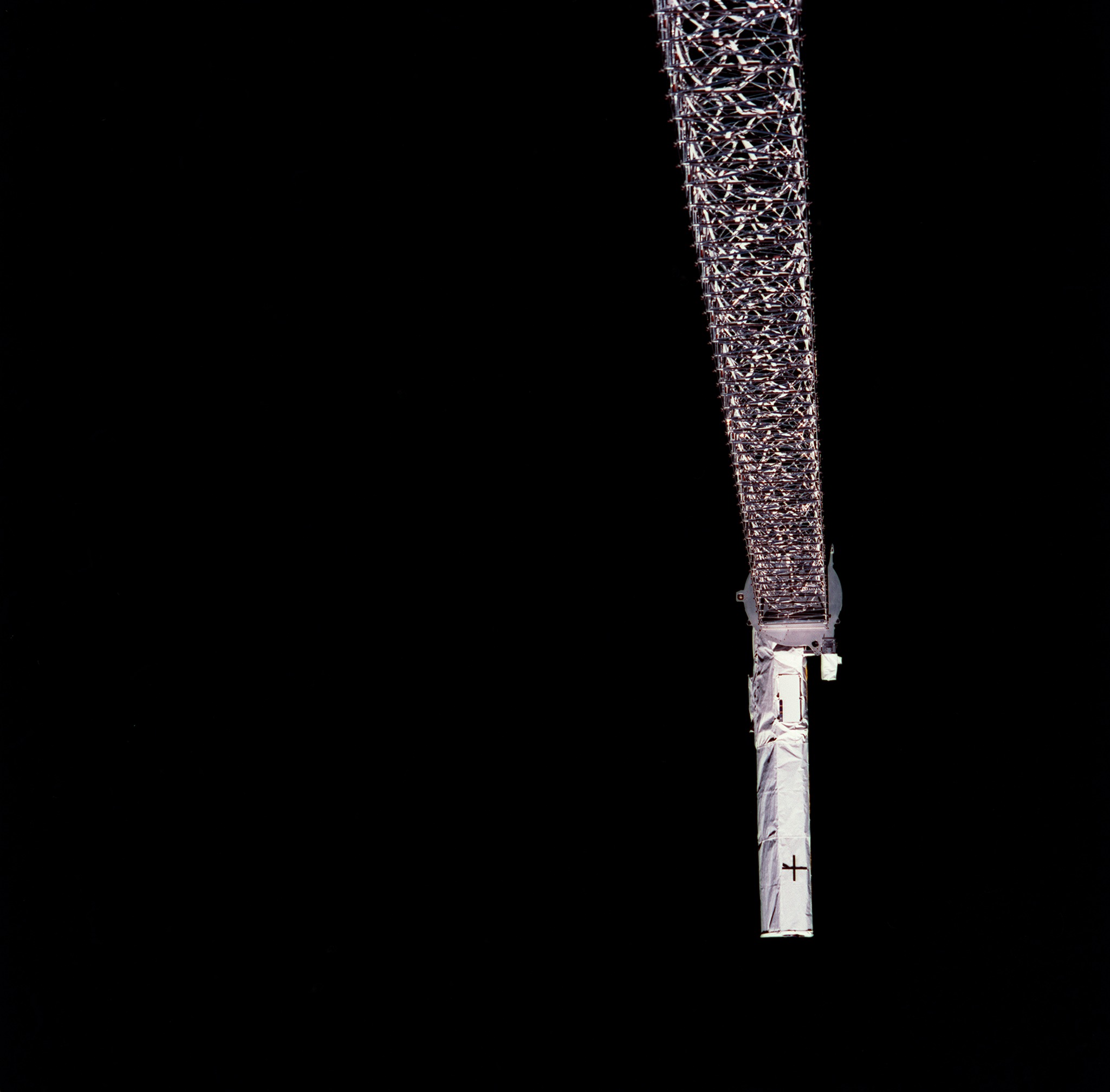
Fifteen years ago, this week, the six-member crew of STS-99—Commander Kevin Kregel, Pilot Dom Gorie, and Mission Specialists Janet Kavandi, Janice Voss, Germany’s Gerhard Thiele, and Japan’s Mamoru Mohri—embarked on the $220 million Shuttle Radar Topography Mission (SRTM) to assemble the most comprehensive maps of Earth to date. As described in yesterday’s AmericaSpace history article, SRTM utilized radar “interferometry,” with a pair of antennas positioned 200 feet (60 meters) apart, one in the payload bay and the other at the end of a deployable mast, and its successful deployment on the first day of the 11-day mission gave Thiele cause for great relief. In time, SRTM would generate 750,000 confirmed users of its data by mid-2011, and its resources have been accessed by people in no less than 221 discrete countries.
With the STS-99 crew split into two 12-hour shifts—“red” and “blue”—it was the responsibility of the red team, consisting of Kregel, Kavandi, and Thiele, to oversee the actual deployment of the mast. “Everything has to go like clockwork and the red shift will deploy the mast, calibrate the radar, verify that both antennas … look at the same point on Earth,” Thiele explained before the flight. “We will calibrate it with the help of the ground, of course, and then at the end of our shift, the mission will be rolling.” If the mast-based Outboard Antenna did not deploy correctly, the mission would be significantly impaired; “not so much that we could not live with a shorter [radar] baseline,” admitted Thiele, “but the key thing here is safety.” The mast needed to be firmly locked in place in order to compensate for shuttle motions, and it could not be firmly locked into place if it was improperly deployed. The criticality of the work to be done by Thiele and his red shift crewmates in the first few hours after Shuttle Endeavour reached space was acute.
However, it soon became evident that the mast’s damping system, which acted as a shock absorber, was not behaving as expected. Mission Control opted to leave the dampers in their “locked” position, since calculations indicated that the mast was at no risk in this configuration and it would not pose any threat in terms of science capability. By the morning of 12 February, less than 18 hours into the STS-99 mission, the SRTM radars had begun their first “swath” over southern Asia and by the end of their first full day in orbit had mapped a total of 1.7 million square miles (4.5 million square km), which was roughly equivalent to an area half the size of the contiguous United States. X-band imagery of White Sands, N.M., was met with delight from investigators at its level of detail and quality.
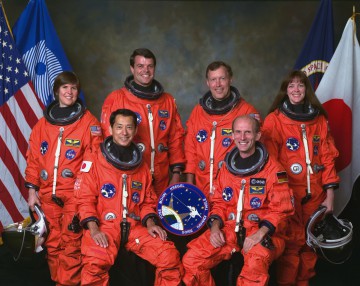
The breadth of their radar mapping covered all of Earth’s southern areas, save Antarctica, and all northern areas to the south of the southern tip of Greenland, southern Alaska, and central Russia. During his second shift, Kregel performed a series of thruster pules to measure the movement of the mast and noted that the tip moved, as predicted, by a matter of less than 11 inches (28 cm). Later, on 13 February, the crew also performed their first so-called “flycast maneuver,” which was designed to reduce strain on the mast and maintain the most optimum conditions for radar mapping. It was named in honour of the casting technique adopted by a fly fisherman and sought to limit the loads on the mast during frequent shuttle attitude-control maneuvers.
“Once a day, because we’re at a fairly low altitude, we have to adjust our orbital altitude,” explained Dom Gorie before launch. “We do that with a couple of reaction control jets in the aft end of the shuttle. If we were to do that without thinking of the ramifications on the mast, we would pulse on the back end of the orbiter with the reaction control jets and the mast would deflect backwards, because of its mass and inertia. Once we stop the burn, if we let it go, the mast would swing back and forth. What we have designed is a maneuver that will minimize the deflections on the mast and minimize the loads at the tip. If we did this without the flycast maneuver, we would have a 3-foot (90-cm) deflection at the mast tip and we would approach the mast limit loads at the base. So we pulse for just a short time, one-sixth of the natural frequency of the mast, and the mast will deflect ‘back’ slightly. Right when it starts springing backwards, we will pulse again and, in essence, ‘catch’ it in its deflected state. We are then burning the reaction control jets for the duration of the burn that it takes to adjust our altitude. When we stop the burn, the mast wants to start swinging back, and, if left alone, it would start flycasting again; it would start twanging back and forth, just like that fly fisherman’s rod. As it reaches back to its neutral position, we do one more pulse at one-sixth the frequency of the mast for that duration and catch it in its neutral position. That way we take those 3 feet (90 cm) of deflection that we would expect without a flycast maneuver and we halve it to 1.5 feet (45 cm) and the mast loads at the tip are halved as well. What we’ve done is designed a maneuver that achieves our end parameters, but greatly reduces the risk of damage to the mast.”
During each of the flycast maneuvers performed during the mission, Endeavour was oriented into a nose-first attitude, with the mast extending away into space, after which the Reaction Control System (RCS) thrusters were pulsed to deflect the mast backwards and then rebound it forward. When it reached “vertical,” a stronger thruster was applied to arrest its motion and increase the orbiter’s velocity, thereby keeping Endeavour in the most optimum altitude for radar mapping.
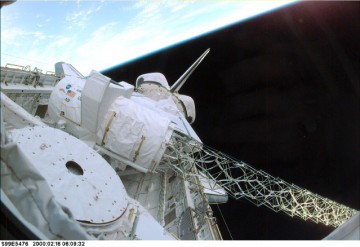
Overall, SRTM operations ran with exceptional smoothness, with flight controllers’ attention drawn only to a minor propellant consumption issue associated with the nitrogen gas thruster at the end of the mast. The thruster was designed to keep the mast from “righting” itself in response to Earth’s gravity and thereby remove the need for additional thruster firings to keep the antenna in its data-collection position. Although propellant was flowing to the thruster, it appeared that little or no thrust was being produced, in spite of the crew periodically cycling its valve open and closed. In the meantime, Kregel and Gorie were required to use orbiter firings to maintain the fine position, which increased propellant expenditure by about 0.07 to 0.15 percent per hour.
However, efforts to conserve propellant were explored over the following days, including a relaxation of the requirement to maintain the mast’s attitude, which was already showing its stability to be far better than predicted. Other measures included changing the manner in which waste water was dumped overboard and limiting the use of non-critical equipment. On the 17th, Gorie cycled the nitrogen line and Voss reported seeing the dislocation of a small, white object, which was presumably a small piece of ice and flight controllers subsequently noticed that the thruster began to generate some thrust. Later that day, propellant conservation measures paid off and the crew was advised that it would be granted a ninth full day of science, as originally intended in the mission plan. “That’s great news,” exulted Gorie. “They’re getting some fantastic data on this mission!”
Fantastic, indeed, for SRTM was uncovering the Home Planet as never seen before. By the evening of 13 February, more than 17.7 million square miles (45.8 million square km), about equal to 38 percent of Earth’s total land masses, had been mapped in unprecedented detail. “We’re starting to see the first ‘quick-look’ results from the X-band and C-band antennas and the details are fantastic,” said SRTM Project Scientist Michael Kobrick of the Jet Propulsion Laboratory (JPL) in Pasadena, Calif. “Even in this lower resolution … we can see many topographic features that were completely invisible in the best maps we have today.” Kobrick later noted that Endeavour’s crew were mapping approximately 38,000 square miles (100,000 square kilometers) every minute, more than tripling the world’s supply of digital terrain elevation data. By the fifth day of the flight, 15 February, more than half of the targeted land surface had been mapped and around 20 percent had been mapped twice, covering regions the size of Africa, North America, and Australia combined. Dozens of sites were mapped two and three times and images of Brazil, South Africa, and New Zealand’s South Island were considered so spectacular in their topographical detail that enthusiastic scientists gushed that the data would be used for decades to come. Although “quick-look” data was available to researchers, the bulk of the SRTM results were stored on about 270 high-density tapes, which contained approximately the same amount of information as 13,500 CDs.
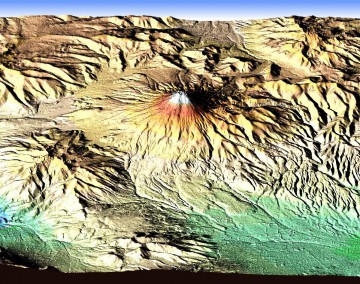
As STS-99 wore on, additional flycast maneuvers continued to fine-tune Endeavour’s orientation. The sixth such manoeuvre of the mission was executed early on 18 February and lasted slightly longer than previous burns, in order to conserve propellant by eliminating another flycast planned for the 20th. By this stage, one week into the 11-day flight, over 83 percent of the pre-launch scientific targets had been mapped on at least one occasion, with over 50 percent surveyed two or more times. NASA explained that the rate of mapping coverage allowed SRTM to cover the equivalent of the state of Alaska in just 15 minutes and Rhode Island in less than two seconds. Images of the San Andreas Fault and the Rose Bowl area of southern California, together with the Kamchatka Peninsula in Russia’s Far East and the Hawaiian island of Oahu were judged as so significant that they could lead to new insights into wildfires, lava flows, tsunamis, and localised flooding. An additional nine hours of mapping time, and, later, on 20 February, an extra 10 minutes, was granted to the crew for their radar observations. Although a seemingly small addition to the timeline, those extra 10 minutes allowed SRTM to radar-map Flinders Island on the northeast corner of Tasmania, which completed the mission’s coverage of Australia and its neighbouring islands in their entirety. It also brought up the total mapping coverage to 99.96 percent of the pre-launch targeted sites. Elsewhere aboard the shuttle, the EarthKAM digital camera acquired more than 2,700 images of the Home Planet on behalf of student investigators from 75 middle schools around the world.
As they worked, the sight of Earth in all its glory in their windows provided an ever-present source of inspiration for the crew. “I can’t see how anyone who’s spent any time in space would say it would be boring,” said Kregel before the flight. “I can spend two weeks easily, just looking out the window. We’re going to be kept pretty busy. We’ve got to do maneuvers every 45 minutes to maintain the accuracy that’s required. We have to change out the tapes. We’re there to back up when ground commanding is not available, to go ahead and start taking the data.” For Janice Voss, who served as “Payload Lead” for the blue shift, it was “beyond my comprehension” that space flight could ever become mundane. “If you ever have a little bit of extra time and … need to change your perspective,” she said, “you would just look out the window and freshen your mind up for a few seconds and come back to what you’re doing.”
With the additional hours of radar time, Endeavour’s mapping period ended at 6:54 a.m. EST on 21 February 2000, about 24 hours ahead of the scheduled return to Earth. The SRTM instruments and the STS-99 crew had imaged almost all of their targeted areas, save small portions of the United States, which were already well characterised in terms of topography. The scientists who oversaw the mission were united in their praise. “A magnificent accomplishment” was Program Scientist Earnest Paylor’s judgement, with Tom Hennig of the Department of Defense’s National Imaging and Mapping Agency (NIMA) adding that its success was “absolutely wonderful.”
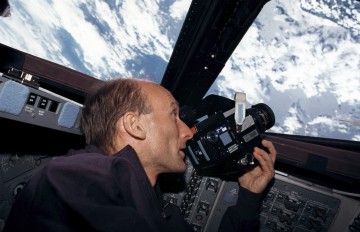
After 222 hours and 23 minutes of uninterrupted radar-data collection, the planned 18-minute process of retracting the 200-foot (60-meter) mast began at 8:17 a.m. EST on 21 February. The procedure ran crisply, until the mast had been retracted to just an inch (2.5 cm) shy of the canister … then stopped. One of the three latches on the canister’s lid had failed to engage properly, although Kregel radioed that from his perspective the protruding segment of mast posed no obstruction and he saw no difficulty in safely closing Endeavour’s payload bay doors at the end of the mission. Nor did he consider it necessary to awaken Kavandi and Thiele for a contingency EVA which did not seem necessary. Mission Control agreed. “Appreciate your concerns for your crew members,” replied Capcom Steve Robinson from Houston. “Our current plans do not include them heading out the door, so I think you can leave them as is.”
Suspicion on the cause of the problem centred on the possibility that the mast had endured cold temperatures whilst fully deployed and that this had reduced its flexibility. At first, the astronauts waited for higher temperatures to warm up any stiffened components inside the canister, then drove open the latches and turned on the retraction motors in the hope that the mast would retract and the latches would re-engage. They did not. “We saw perhaps just a tiny movement at initial power-up, but then nothing else,” reported Kregel, glumly, “and, of course, you saw the currents were pretty high.” Even switching the retraction motors to their maximum torque only served to move the mast by an additional quarter-inch (0.6 cm), then stalled. Finally, after three failed attempts, the mast was successfully folded into its canister.
That almost 10 full days, or 223 hours, of mapping time was acquired was quite remarkable. Original plans called for 10 days and 10 hours (a total of 250 hours) of mapping operations, with the shutdown of the radar instruments and the retraction of the mast on the day before landing. However, in late January 2000 NASA managers had opted to halt operations about 24 hours earlier, giving the SRTM teams only nine days for science. The reason was linked to nervousness about how well the mast would retract at the end of the mission and to preserve the option for a contingency spacewalk. If Janet Kavandi and Gerhard Thiele were required to perform an EVA to manually crank the mast closed, they would need the additional time to prepare their space suits, pre-breathe pure oxygen, and perform the spacewalk itself.
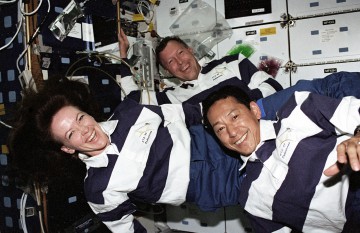
Leaving the retraction until the final day before landing offered no time in the flight plan to handle unforeseen problems. Also, since the radar consumed so much energy during the mission (about 900 kilowatt-hours, or enough to power an average home on Earth for two months), an EVA would not have been possible after a full 250 hours of mapping. “This is a device we’ve never deployed before,” explained STS-99 Lead Flight Director Paul Dye. “It’s the longest space structure anybody’s ever put out and we would like to be able to get it back. If we had a problem on the stow day, we’d have had no opportunity to try to fix that problem with an EVA or other means. We had stretched the mission as long as we possibly could.” Dye compared taking 24 hours off the mapping time as the difference between “a glass that’s 10 percent empty or 90 percent full.” With the extension of mapping activities by the additional nine hours, then an additional 10 minutes on top of that, most of SRTM’s originally baselined radar time was met.
When judging the success of SRTM, the numbers spoke for themselves: eight terabytes of data collected, 332 high-density data tapes (equivalent to more than 20,600 CDs) filled, 99.98 percent of targeted sites mapped on at least one occasion, and 94.6 percent of it mapped on at least two occasions. In fact, several sites, with a total land area larger than the United States, were mapped as many as four times during the flight. In years to come, it was expected that the SRTM data would support a range of civilian and military applications, including the enhancement of ground collision-avoidance systems for aircraft, civil engineering projects, land-use planning, disaster recovery, line-of-sight determination for cellular communications, the development of better flight simulators, logistical planning, air traffic management, missile and weapons guidance systems, and battlefield management tactics.
“There are a lot of benefits for our lives,” explained Mamoru Mohri, drawing particular attention to a huge earthquake which hit the harbor city of Kobe, on the southern side of the Japanese island of Honshū in January 1995. “More than 5,000 people were killed. This tragedy happened because of the fact that some houses were built on a fault … and this fault could not be predicted to cause such serious damage. If we had known the land more precisely, thousands of lives could have been saved. There are many unstable ground areas in the world and in the future we may be able to alert people who live in such areas about imminent dangers.”
Landing day for STS-99, on 22 February 2000, brought news of weather conditions which seemed grim and questionable to support Endeavour’s return to Earth. High winds and potential heavy cloud cover seriously threatened the orbiter’s return to KSC. On the West Coast of the United States, Edwards Air Force Base, Calif., had been activated and placed on standby to support the landing if necessary. The first KSC opportunity, which would have produced a landing on Runway 33 at 4:50 p.m. EST, was waved off, due to ongoing concerns about the weather, but the Mission Management Team (MMT) eventually opted for the second opportunity.
Kregel and Gorie guided Endeavour to a smooth touchdown on KSC’s Runway 33 at 6:22 p.m. EST, closing out a spectacularly successful 11-day mission. They had uncovered the Home Planet as never before and had established themselves as the first humans to journey into space in the Year 2000. With the Mir space station having been vacated by its most recent long-duration crew in August 1999, the year had begun with not a single human being in orbit around Earth. The STS-99 crew gained the honor of being first purely by happenstance, but there surely could have been no better mission to begin a new millennium than one which turned our gaze back to the cradle from which we came and enhanced our understanding of its beauty, its majesty, and its mystery.
This is part of a series of history articles, which will appear each weekend, barring any major news stories. Next week’s article will focus on the 30th anniversary of the unfortunate Mission 51E, a shuttle flight which came so close—and yet so far—to launch … but witnessed the birth of an entirely new mission.
Want to keep up-to-date with all things space? Be sure to “Like” AmericaSpace on Facebook and follow us on Twitter: @AmericaSpace




SRTM is still the go to DEM for the parts of the earth where a national mapping agency has not made something better available (usually for national security reasons). While the Japanese did make an ASTER DEM available at higher resolution for areas outside the US, its has systematic errors higher than those of SRTM 5 DEM. More recently the US decided to finally release 30 m DEM for outside the US where available (until now only 100 m DEM was available for outside the US), which means SRTM now has higher resolution than ASTER DEM. However I have read that the one of the receivers did fail near the end of the mission, which meant that not the whole world can be mapped at 30 m pixel resolution in SRTM DEM.